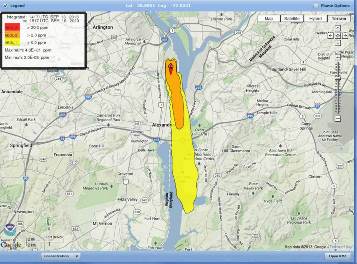September, 2013
After extensive development and testing by NOAA’s Air Resources Laboratory (ARL) and NOAA’s Office of Response and Restoration (OR&R), a new Hybrid Single Particle Lagrangian Integrated Trajectory (HYSPLIT) web-based modeling system was successfully installed at the NOAA Web Operations Center (WOC). This system provides NOAA National Weather Service (NWS) forecasters with the ability to first simulate a release of a hazardous chemical to the atmosphere, using the extensive scenario-based source term configuration of the Areal Locations of Hazardous Atmospheres (ALOHA) model developed by OR&R and the Environmental Protection Agency, and then simulate the resulting plume, using the HYSPLIT atmospheric transport and dispersion model developed by ARL. Based on user input, the ALOHA model creates a time-varying release rate that is used by HYSPLIT for transport and dispersion calculations. The HYSPLIT system also has menu-driven capabilities to simulate the release of other hazardous pollutants to the atmosphere, such as smoke and radiological contaminants. A series of webinars is being planned by ARL and OR&R to familiarize NWS forecasters with the new system and its required and optional inputs.

HYSPLIT model results for a fictitious chlorine spill near Washington, D.C. using the ALOHA toxic release model to describe the time-varying release rate to the atmosphere. Colors depict decreasing concentrations of the chlorine plume as it disperses away from the source area (red color). Image Source: NOAA/ARL
Background:One of ARL’s long-term research goals is to generate a coordinated suite of NOAA plume prediction tools to support the needs of both internal and external researchers. The web-based Real-time Environmental Applications and Display sYstem was designed in 1997 to meet this overall goal by providing users (largely atmospheric scientists) with access to the HYSPLIT model, along with a suite of operational NOAA meteorological forecast data sets. NWS forecasters have an operational (24/7) need to provide local and state emergency managers with plume forecasts tailored to their specific needs, such as a wild fire event or a chemical or radiological release. Thus, there was a need for an operational web site with HYSPLIT products specifically designed for atmospheric emergencies of this type.
A pilot project was initiated in 2007 to deploy a web-based version of the HYSPLIT model to an operational environment (the WOC) rather than the laboratory-operated READY web site, and to create the tools that allow the NWS forecasters to directly meet customer’s needs. This new modeling system is a major update to the original WOC web site and greatly enhances the quality of the dispersion products.
Significance:The accidental or intentional release of chemical, biological or nuclear agents can have significant health, safety, security, economic, and ecological implications. By providing the weather forecasters in the field with direct access to the HYSPLIT dispersion model using an intuitive series of web forms, forecasters can provide their clients with the products they desire in less time, without having to wait for the transmission of the products from a central point of contact and subsequent retransmission to their clients. In addition, by combining the familiar ALOHA chemical source term model with the HYSPLIT transport and dispersion model, forecasters can be more specific when defining the pollutant release rate and in return provide emergency managers with an improved forecast plume product.
A pdf copy of this article contains a larger image.

